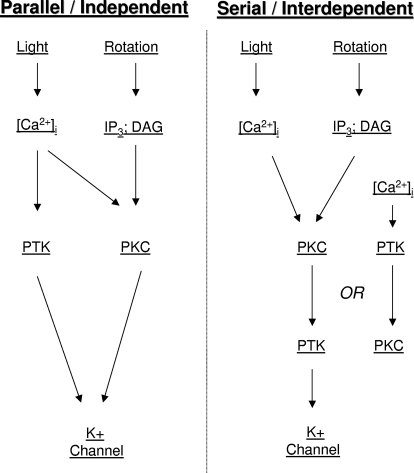Fig. 15.
Models for PTK and PKC interactions in the production of learning-produced changes in Hermissenda type B cell excitability. In the parallel/independent model (left), light leads to increases in intracellular calcium within B cells, whereas rotation leads to neurotransmitter (e.g., serotonin [5-HT] and γ-aminobutyric acid) stimulation of G-protein–triggered signal-transduction pathways, including those that result in membrane phospholipid hydrolysis and the production of IP3 and diacylglycerol (DAG). In this model, pairing specificity arises from the requirements for kinase activation (temporally contiguous increase in both intracellular calcium ion concentration, [Ca2+]i, and DAG are necessary for PKC activation) and the differential ability of each sensory stimulus to stimulate [Ca2+]i and DAG increases. Although IP3 would be produced by rotational stimulation and thereby lead to [Ca2+]i increases (in addition to DAG), we suggest that the [Ca2+]i increases produced are normally below the threshold needed for PKC activation. Thus repeated exposures to rotational stimulation in the absence of paired light presentations would be insufficient to induce PKC-mediated changes in B cell excitability. Similarly, in the case of PTK activation, we assume that for a calcium-dependent, nonreceptor-type PTK (e.g., PYK2), light-induced [Ca2+]i increases may be insufficient to activate the kinase unless rotation also adds to [Ca2+]i increases. Alternatively, the PTK(s) activated during conditioning may be receptor-type PTKs, dependent on both rotation-mediated stimulation and light-induced [Ca2+]i increases within B cells for their activation. In a second class of models (serial/interdependent, right), PTKs and PKCs interact and affect one another (see discussion). One possible interaction between PTKs and PKC in type B photoreceptors might involve PTK participation in activation of PLC-γ and subsequent activation of PKC by DAG and IP3. Our data are most consistent with the parallel/independent model (left).

